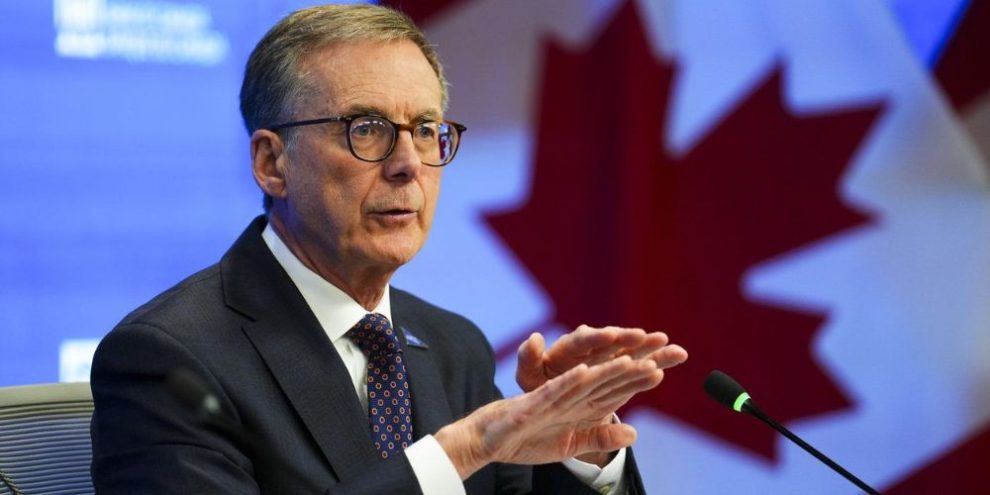
Updated October 29, 2025 @ 3:28pm
The Bank of Canada is signalling it might be done cutting interest rates in the short term but that doesn't mean economic growth is going to pick up quickly after a "structural" hit from U.S. tariffs.
The central bank lowered its benchmark interest rate to 2.25 per cent with a second consecutive cut on Wednesday.
Bank of Canada governor Tiff Macklem told reporters after the announcement that monetary policy-makers feel the key rate is at “about the right level” to keep inflation close to the bank's two per cent target while supporting the economy through tariff disruptions — provided the economy evolves in line with its forecasts.
Economists widely expected Wednesday’s cut as Canada’s economy shows cracks from U.S. tariffs but inflation appears largely under control.
Barrie's News Delivered To Your Inbox
By submitting this form, you are consenting to receive marketing emails from: Central Ontario Broadcasting, 431 Huronia Rd, Barrie, Ontario, CA, https://www.cobroadcasting.com. You can revoke your consent to receive emails at any time by using the SafeUnsubscribe® link, found at the bottom of every email. Emails are serviced by Constant Contact
Macklem said the central bank is expecting the pressures pushing inflation higher — costs related to tariffs, for example — will be largely offset by a weaker economy going forward.
He also said there isn't much more the Bank of Canada can do at this point to help the country through the turmoil tied to tariffs — something he considers a structural shock to the economy, not a cyclical or temporary one.
"Monetary policy can't target specific sectors … it can't help companies find new markets, it can't help companies reconfigure their supply chains," he said.
"What it can do is it can try to mitigate the spillovers from the hard-hit sectors to the rest of the economy."
The Bank of Canada returned to publishing a central forecast for the economy and inflation Wednesday, a practice it had foregone since January as tariffs clouded its outlook.
After the economy contracted in response to a sharp drop in exports in the second quarter, the bank now sees modest annualized GDP growth of 0.5 per cent this quarter and one per cent in the fourth quarter.
The forecasts show growth will likely be restrained in the next two years, averaging 1.4 per cent, as population growth slows and Canadian exporters attempt to diversify beyond the U.S. market.
The central bank expects trade disruptions will structurally reduce the size of Canada’s economy and forecasts GDP will be 1.5 per cent lower by the end of 2026 than its projections before U.S. tariffs were imposed earlier this year.
Macklem warned that Canada must work to boost its productivity in the face of this weaker growth or face harsh economic consequences.
"Unless we change some other things, our standard of living as a country, Canadians, is going to be lower than it otherwise would have been," he said.
Tony Stillo, director of Canada economics at Oxford Economics, said in an interview that the central bank's updated forecasts are largely in line with his own.
Though Canada's economy will be growing on the whole, communities relying on tariffed sectors like steel, aluminum and lumber will have it worse, Stillo warned.
"You'll hear people talking about tough times," he said.
Compared to the central bank's forecasts, Stillo sees growth rebounding faster by 2027 after Ottawa hopefully lands a deal to end most U.S. duties. The Bank of Canada's forecasts use today's tariff levels as its baseline.
The monetary policy report estimated the average U.S. tariff rate across all Canadian goods sits just shy of six per cent today; Canada's counter-tariffs on the United States meanwhile average out to roughly one per cent, according to the central bank.
U.S. tariff policy remains “unpredictable,” Macklem noted. He made a brief reference to U.S. President Donald Trump’s decision over the past week to abruptly halt trade talks with Canada over an Ontario ad campaign and threats to impose an extra 10 per cent tariff on Canadian goods.
This environment means the Bank of Canada can’t put as much stake in its forecasts as usual.
“The range of possible outcomes is wider than usual — we need to be humble about our forecast. If the outlook changes, we are prepared to respond,” Macklem said.
What constitutes a material change to the bank is not one month of readings or a single data point, Macklem said, but an "accumulation of evidence" that the economy is shifting according to the central bank's baseline.
The Bank of Canada will get another significant input for its modelling next week when the federal government tables its long-awaited fall budget.
Macklem has long said that while monetary policy is limited in how much it can support the economy through the trade disruption, fiscal policy-makers can provide targeted supports to respond to tariffs.
The governor was typically tight-lipped when asked how Ottawa should respond to current economic challenges in next week's budget — the Bank of Canada operates independently from the federal government — but said the central bank would weigh the spending plan based on how it added to both supply and demand forces in the economy.
Stillo said stimulative federal spending will likely hold the Bank of Canada back from steeper cuts in this cycle.
"The heavy lifting is going to come from the fiscal side. And that's what we're expecting to see in the federal budget next week," he said.
Stillo expects the bank will hold its benchmark rate steady through to 2027, at which point a return to growth might warrant higher rates.
But he also doesn't rule out additional cuts of a quarter to a half percentage point if the bank sees the economy deteriorate sharply.
"That would be a much more dire outcome for the economy than we have in our baseline," he said.
Stephen Brown, deputy chief North America economist with Capital Economics, said in a note to clients Wednesday that he expects the bank will continue to reduce its policy rate to as low as 1.75 per cent in 2026.
He said he is expecting GDP will come in a touch lower than the Bank of Canada is now projecting in the years ahead, pushing inflation even lower and warranting more rate-cut relief for the economy.
BMO senior economist Robert Kavcic said he also believes additional cuts are not off the table.
"We believe that ongoing softness in the job market leaves the door open for some further support, and another (quarter-point cut) is still on the table for early 2026," he said in a note.
Lenders including CIBC, RBC, TD, BMO and National Bank all announced they would match the size of the Bank of Canada's rate reduction by lowering their prime lending rate to 4.45 per cent from 4.7 per cent, effective Thursday.
The Bank of Canada's final interest rate decision of the year is set for Dec. 10.
This report by The Canadian Press was first published Oct. 29 2025.





